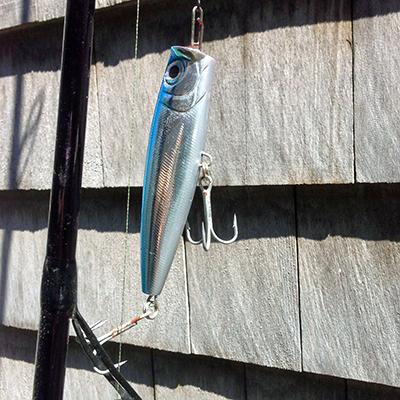Think Outside the Tackle Box

Every angler has a favorite lure in his or her tackle box. For some it’s a simple bucktail jig. For others it’s a wood plug or a shiny tin. But for many anglers it’s a Rapala, the Original Floater, the classic balsa wood minnow imitation.
The Rapala was invented in 1936 by Lauri Rapala, a Finnish fisherman who observed that large fish typically targeted injured prey, particularly those that swam with a slightly off-center wobble. He decided to create a lure that imitated the action of a wounded minnow to earn some additional income and save time baiting hooks. Rapala used a shoemaker’s knife and sandpaper to shape a piece of cork that perfectly imitated the wiggle-wobble or twerk, as the young ’uns might say, of an injured baitfish. He wrapped the cork in tinfoil from consumed chocolate bars to create a reflective surface and melted photographic negatives to form a protective coating. As the size of Rapala’s catch grew, so did the legend of his lure and the demand for it. Today Rapala is the world’s largest lure manufacturer, with some 20 million units sold across 140 nations.
One would think an angler’s favorite lure is the one that catches the most fish. But sometimes it’s the beauty of the lure’s craftsmanship rather than its production that elevates it to the number-one position in the tackle box. In fact, a favorite lure may never see water. Danger lurks there. Bluefish with razor-sharp teeth are waiting to mangle that cherished handcrafted wood plug with multiple layers of glistening paint. Catching such toothy critters is a job for the favorite’s scraped, tarnished, and bent-hooked siblings or the orphan stepbrother rusting in the bed of the pickup truck.
It’s not unusual for fishermen to keep their favorite lure protected in the original packaging right up until the time it’s needed. Less important lures are unpackaged immediately after purchase and thrown into the tacklebox with reckless abandon and with no concern for scraped finishes.
Don’t ever ask a fellow fisherman or loved one to borrow his or her favorite lure. That’s just crossing the line. Better to go fishless that day. Sorry. If a fisherman goes temporarily insane and offers up their prized one, refuse it with deep gratitude. For if it’s lost in the mouth of a fish or otherwise, the story will be told again and again for eternity plus one day.
At Ditch Plain in Montauk, a steady flow of small stripers has been responding to white bucktails and swim shads, Paulie Apostolides at Paulie’s Tackle in Montauk reported. “Afternoons are better than the mornings,” he said, speculating that the still chilly water temperature had something to do with what appears to be a certain dawn-time lethargy.
The cool half of spring means that though there may be fewer baitfish in the bay, striped bass sneak up into East End creeks and grassy harbor edges, where they can snack on the hardy killifish that make their home there. As the waters get warmer, the options for anglers get better and better as more stripers arrive and their dining options multiply.
“There are loads of little bass around,” Ken Morse of Tight Lines Tackle in Sag Harbor said on Monday. Their apparent numbers were a good sign for the future of the fishery, he said. Sunset and into the evening seemed to have been the ticket, which Morse suspected had to do with the water heating up during the day, goading fish to getting their chew on.
Most of the reports he had heard from anglers came from people fishing along the shore; few had ventured out yet by boat that he knew about other than a man who said he had trolled up a bluefish near the South Ferry slip and a few folks who had scored a few porgies. “Most people I know hold off until fluke season,” which opens May 17, he said.
Harvey Bennett of the Tackle Shop in Amagansett suggested that early indications for fishing in Gardiner’s Bay were strong. A trap fisherman of his acquaintance, he said, found about half a dozen fluke in his net that would have topped six pounds and one that might have weighed more than 10. But what really blew Bennett’s mind were in the back of the guy’s truck, what he called the biggest porgies he had ever seen — “These were porgies so big that I had to ask him what they were. I’ve never seen anything like it. They were like the Godzillas of Porgyland.”
Bennett said that early, hungry bluefish, more skin and bones than flesh, have been around and that there were reports of shad as well. “A guy caught a couple on the ocean just messing around. He said he saw them flipping and tried it.” Squid had appeared in the bay as well, he said.
Alewives had made it back in a big way into Big Fresh Pond in Southampton to spawn, drawing black-crowned night herons, blue herons, egrets, and osprey, Morse said. Though the herring-family fish are off-limits to harvesters, they make a fine meal to the bass and other predators that feed upon them. Big, hungry bass can sometimes be picked up as they prowl narrow East End backwaters looking for an easy mouthful.
With Reporting by David E. Rattray
